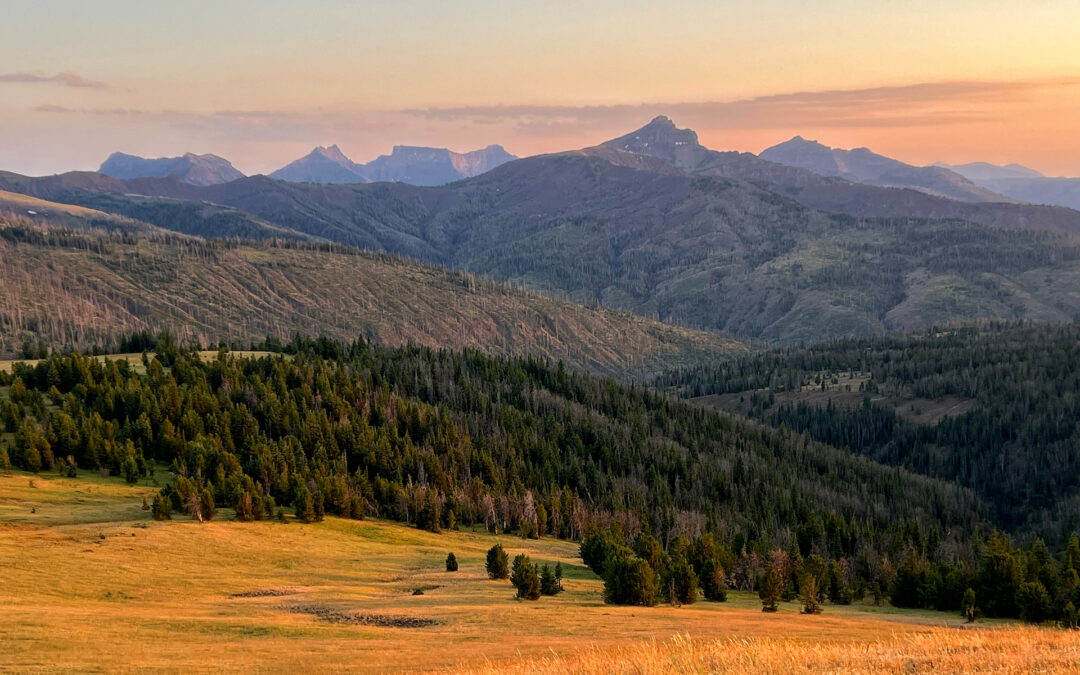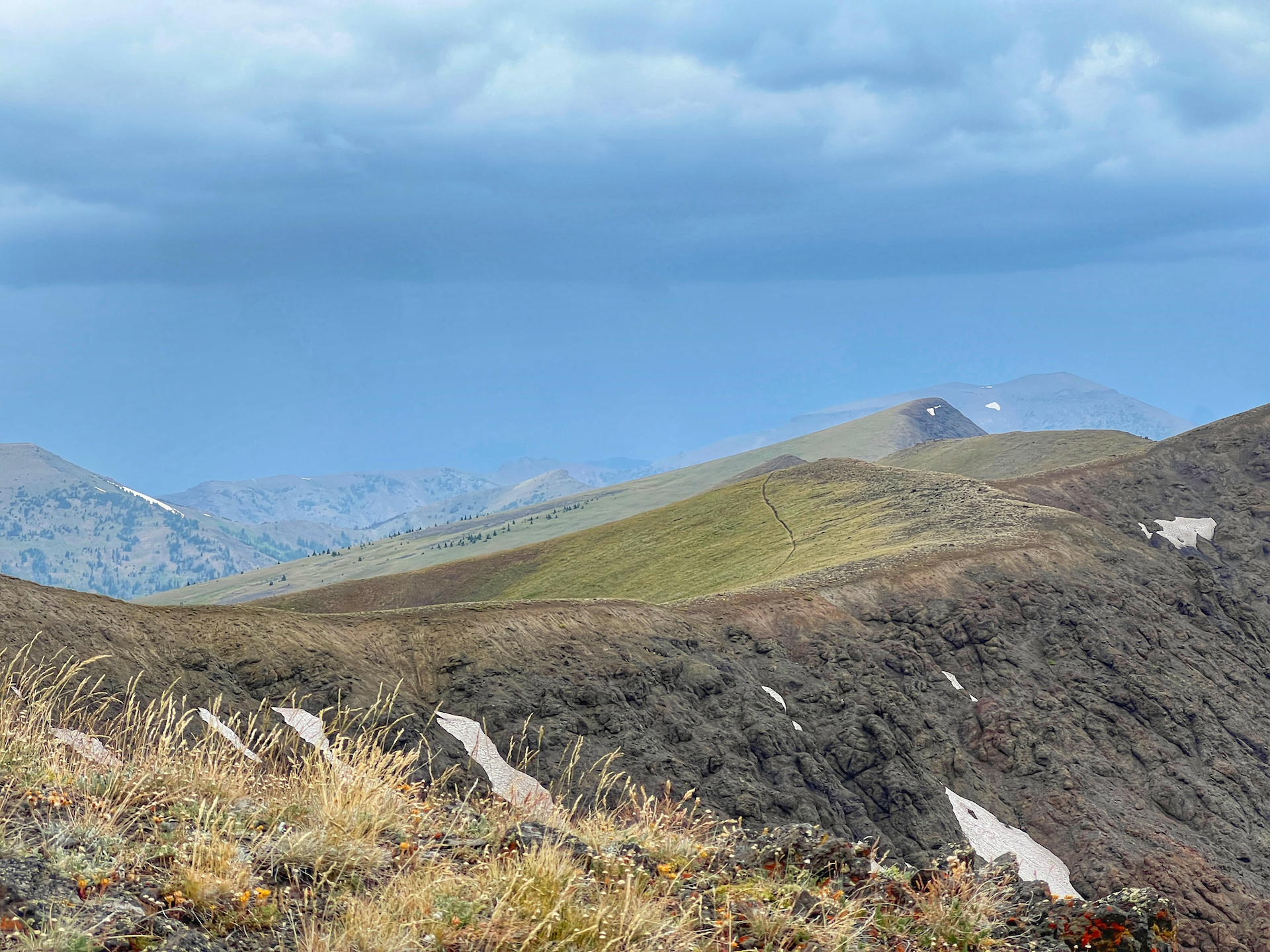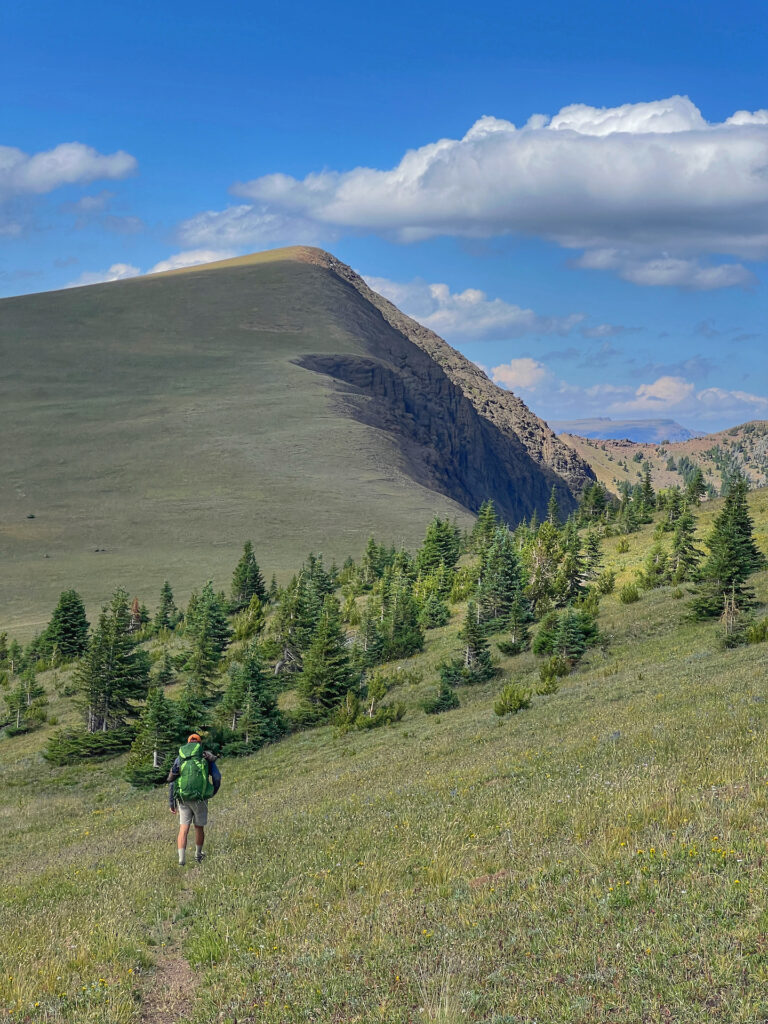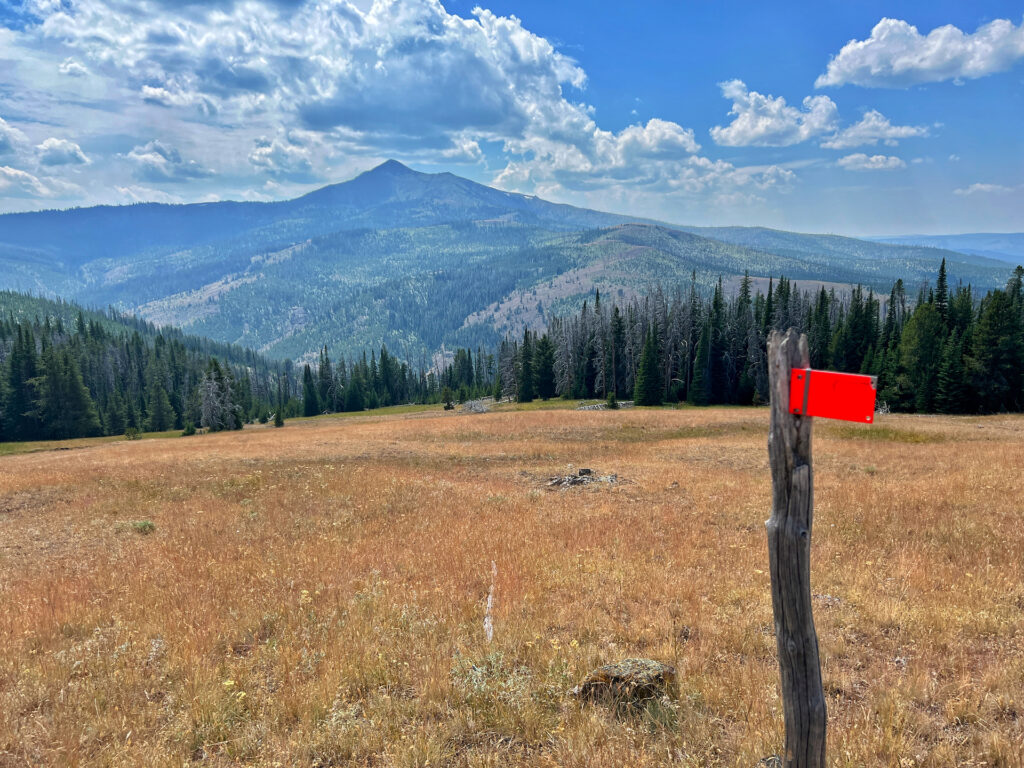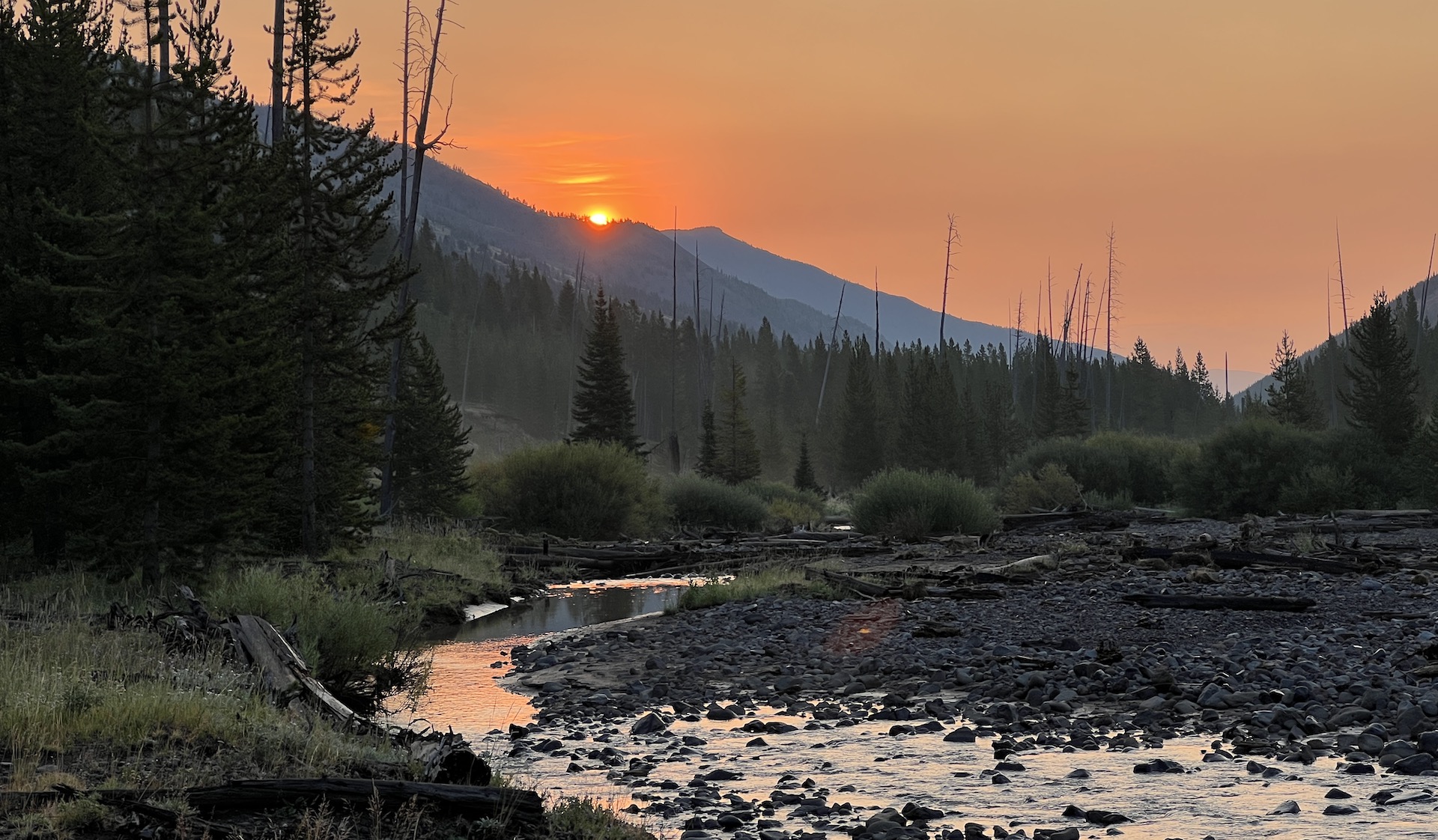In early August, George and I and our friend Julianne embarked on a 54 mile backpacking trip through the high and wild Absaroka Mountains from Sunlight Basin to Crandall Creek. This is the section Julianne and I were unable to complete last year during my 200 mile backpacking journey through Greater Yellowstone; we got turned away from the high passes by snow and wanted to complete that section this summer.
I knew from the planning last year that this hike would be BIG. It was going to be one of the more difficult sections of the entire hike from Turpin Meadows outside of Grand Teton to Gardiner at Yellowstone’s north entrance. And this hike certainty lived up to that. Here’s the journal from the trip.
Day 1: Sunlight Basin
After dropping the car at the North Crandall trailhead along the Chief Joseph Highway, we drive way back in the impossibly beautiful and remote Sunlight Basin to the start of our hike, traversing a rough narrow two-track to a tiny parking spot at the first creek crossing. Here begins our journey!
We have four miles today up the two track from our parking spot at the creek crossing. It’s HOT!! The trail is popular with ATV adventurers, so we steel ourselves for lots of noise and company until we hit the wilderness day after tomorrow.
While it isn’t the greatest campsite, we finally find a sheltered spot with enough room for two tents and a leaning dead tree for the bear hang, complete with old moose and bear scat. Despite the motorized use along the roadway, this drainage feels incredibly wild; severe and steep and filled with bears and moose.
In the evening, we walk down to hang by the creek. George plays with stones and Julianne and I paint wildflowers – Indian paintbrush, harebells, monkey flower, clover.
Day 2: Hiking Hughes Basin
Today we climbed up and up and up and up around 3000 feet to view Hughes Pass, the North Fork Shoshone drainage, and the route we would’ve taken from Silvertip Basin had we been able to climb around or over the rock-hard, 40 degree snow field that blocked our path.
The route is on a 4wd two track, which eventually becomes very steep and washed out towards the top, the loose rock of the crags above sloughing off and making a mockery of the man-made track. Past the washout, we leave the ATV’s behind and pick our way carefully across the loose talus and slippery gravel, cursing every now and again as one of us slips and catches ourselves before tumbling down.
At the top, Hughes Basin spreads out bright green below, the purple mountains marching on into the horizon, endless miles of wilderness. The landscape is austere, and frankly intimidating. We enjoy the bright sun, the breeze, and the feeling of being on top of the world, and spend a few minutes journaling.
Day 3: The long and arduous climb to Hoodoo Basin
In my tent at the end of this epic day I’m not sure I have much energy to write…but I’ll try. Not gonna lie, the trail out of Sunlight Basin to the Yellowstone National Park border on the ridge high above is HARD. George and I hiked it nearly 20 years ago, and I remembered it being difficult, but….somehow it felt a lot harder this time around.
We start out walking through a primeval forest, deep and wild, climbing over downed logs for several miles before ascending straight up, no switchbacks, for hours, one slow step and breath at a time. 3,043 feet straight up! We stumble breathlessly to the top of the stunningly beautiful ridge only to find a thunderstorm barreling right at us, with no shelter or trees for miles.
So we rally our energy for a quick dash up and over the ridge, where we drop down 250 yards from the top to wait out the storm, spread apart, amongst some scattered fir trees, just barely taller than we were sitting.
We put on our rain gear and pack covers and sit in the rain, as the storm blows in sheets all around us. I love it, on a certain level.
Just as I settle into my hunker down spot on the open alpine to wait out the storm, I see a white butterfly- a Rocky Mountain Parnassian, crawling leg by leg towards my foot. It takes shelter from the storm on my boot in a spot that’s sheltered by my rain pants. I feel a kinship with this tiny, fragile being, who one large raindrop can pummel, both of us small and insignificant in our own way out here. It’s so fragile and beautiful and I feel so honored to provide it shelter that I dare not move a muscle and disturb its hiding place even though my legs are aching and then numb. I tilt the angle of my foot just a bit when the direction of the rain shifts, to keep the butterfly sheltered.
After the storm cleared, we were treated to gorgeous green hills and peaks fanning out into the horizon.
I celebrated with the mother of all nosebleeds, blood spurting everywhere. Blood on your pack or clothes takes on a whole new meaning in bear country…
The last couple of miles felt like they took forever, Julianne and I near the edge of our endurance, and George, limping from a fall he took slipping on some loose dirt. We got set up just in time to jump in the tent and hold it up from the inside as another storm laid it down almost vertical on top of us. Once the storm cleared, we had dinner and I mustered the energy to walk to the top of the knob above camp. Now we’re in for the night, and I am utterly, truly exhausted, wondering what the heck I was thinking…did I underestimate my ability to pull this off?
Day 4: Traversing the Hoodoos and a Steep Descent to Miller Creek
What do I love about backpacking? I love the decision making (get water here, or will that intermittent stream be running later? Try to make it over the ridge before the lightning storm or wait here for hours? ) I love the discomfort. Yes, the discomfort, which we don’t get nearly enough of in our “sheltered, temperature-controlled, overfed, under-challenged lives” as Michael Easter of the book the Comfort Crisis asserts.
Above all I love the full body sensory experience; the colors, the textures, the feel of the sun, or wet branches on my skin, the ability to detect subtle changes in the coolness or dampness or warmth or scorching-ness of the air. The feel of my muscles tight from a steep climb the day before, the air rushing into my lungs when I heave a breath, the way my feet plant on the ground as I cross a down log. I love the appreciation for my body, which, despite the pain and strain and discomfort and sweat and stink remarkably does what I ask it to. And then wakes up and does it again the next day and the next. I love feeling the soft parts of my skin and muscles rub raw and then harden in strength and resilience. These are things we don’t get to experience much in our sterilized comfortable lives.
And so, even though I was challenged to the max from the hike yesterday, I get up and do it all over again.
The morning is bright and sunny for our walk through the ethereal eroded formations of the Hoodoos, spotting a mountain goat mom and kid on the slopes high above. We pause on the top of the ridge above Miller Creek and the headwaters of the Lamar River before a punishing descent through crisp-dry high meadows to the lush Miller Creek below.
We arrive stumbling (again) at our camp amongst stately, towering spruce and fir trees. I am desperately looking forward to taking a dip in the creek, which to our chagrin ends up being roughly a quarter mile from our site through a maze of deadfall and bear scat. After tuning up a chorus of foul language and coming close to tears, I finally find a route to the water and dunk in. I hobble back over downed logs to show Julianne and George the way, and we spend some lovely time sprawled out on the river cobbles soaking up the water and sun. Later, dry in our tents, a steady rain lulls us to sleep.
Day 5: Wild and Remote Timber Creek
We rise early early and walk a lovely 4 miles from Miller Creek to Canoe Lake, the trail a much gentler climb than any of our days so far, through deep forest marked at regular intervals by bear scratches and bites on trees. At Canoe Lake, we lay out our wet tents, and make breakfast. George hikes down to jump in the lake and retrieve water, bringing back freshwater shrimp by accident in the water bag, which we released back into the lake to live out their lives.
The hike down from the park border and the pass between Canoe Lake and Timber Creek is steep and filled with tiny pebbles we call “ball bearings” that slip under our feet as we navigate deadfall on the steep slopes. There is not a sign of horse or human anywhere save for some very old cut logs from long ago tree clearing.
As we reach the creek drainage, a storm barrels in, pelting us with rain, and then hail. We keep hiking through uniform lodgepole pine regrowth, George and I laughing giddily as we do during backcountry rainstorms, crossing swollen creeks hot chocolate brown with runoff.
We camp in an old outfitter camp now abandoned and covered in huge Douglas Fir deadfall, tucked in between towering green boughs near the river. George exclaims when a huge surge of water rushing down from all those tributaries finally hits the main channel of Timber Creek. The water is too brown to filter, so George walks back upstream until he finds a small creek that has started running somewhat clear again.
The next morning, smoke haze turns the rising sun deep orange as we pack for the trail.
Day 6 Working Our Way Down Crandall Creek
It’s our last night out, perched on a limestone bluff above Crandall Creek. It was another epic day filled with wonder and challenge. The hike started in gorgeous fairy forest along the river, nearly every trailside tree marked by bears, scat every 100 yards, along with elk and deer and fox tracks. Not as many fresh tracks as I would’ve expected in the mud after the epic hailstorm from the day before.
We leave the deep woods and climb to a narrow ledge on a nearly sheer cliff face where a two-boot wide track is somehow etched into the face, rock crumbling away to the chasm below, where the still chocolate-colored Timber Creek winds through crumbling ledges and slick rock beds. We traverse the ledge for several miles, an anxiety and pucker inducing walk. Beautiful, harsh, remote, very cool to witness, but a little too edgy for too long for my taste.
After lunch overlooking the impossibly severe flanks of Closed Creek, we descend to the lush bed of Closed Creek, where we filter pale milk-tea colored water before we find our way across.
Up in the heat we go over a couple high bluffs to another creek crossing and a lovely flat camp along what has now become Crandall Creek with the joining of Closed and Timber Creeks. We share the site with three guys doing fish surveys. Two other men with a hunting dog and a string of pack animals come through camp on their way upstream. They seemed surprised we walked all the way here from Sunlight Basin. After dinner, I walk to the confluence with Papoose Creek and return to sit on the bluff and watch the sun go down. There’s a weird something blowing in, smoke, or fog, we can’t tell. If it’s low, and likely relatively close, which is nerve-racking. We can’t tell if the smell of smoke is entirely from the fish guys campfire or from something larger.
Tomorrow, it’s about 10 miles out, all downhill save for about a thousand foot climb first thing in the morning to get around impassable cliffs and canyons along Crandall Creek.
Finally, on the 7th day, I feel really good, like my body is becoming accustomed to the work and the weight. I feel like I could pick up more food and keep going for another week! I love everything about being out here – the sensory experience of being in the woods all day, every day is second to none. Truly. All in all we did 54.5 miles by my calculations through some incredibly remote and wild wilderness.
Can't get enough of the Yellowstone and Montana backcountry? You can see all our backcountry adventure stories here.
Want a copy of Jenny's backpacking list? You can grab that here.

